Introduction to Ancient Egyptian Gods
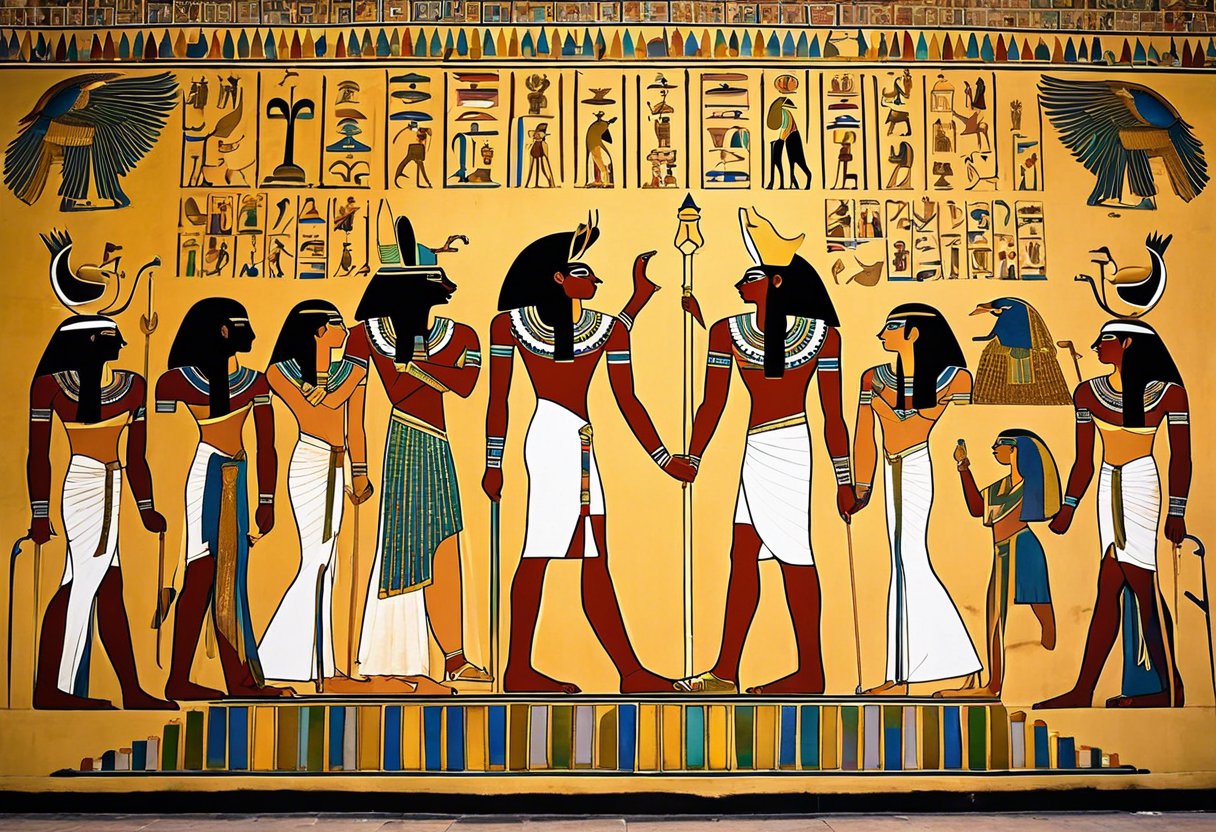
Ancient Egyptian mythology is rich with a diverse pantheon of gods and goddesses, each with their own unique characteristics and roles. These deities played a central role in the religious beliefs and practices of the ancient Egyptians, influencing every aspect of their lives.
The ancient Egyptian gods were believed to have control over various natural phenomena and aspects of human existence. They were seen as both powerful and divine beings, capable of shaping the world and determining the fate of individuals.
Ancient Egyptians believed that the gods and goddesses interacted with humans on a daily basis, offering guidance, protection, and blessings. They were revered and worshipped through the construction and maintenance of magnificent temples, which were seen as the house of the gods.
The ancient Egyptian pantheon consisted of a vast number of deities, including major gods and local gods worshipped in specific regions. Some of the most prominent gods and goddesses include:
Ra: The sun god, often depicted with a falcon head, was considered the most important deity in ancient Egyptian mythology. He represented the sun and the concept of creation, and his cult centers were located in Heliopolis and Memphis.
Isis: The goddess of magic, fertility, and motherhood, Isis played a crucial role as the wife and sister of Osiris. She was widely worshipped throughout ancient Egypt and was believed to have a powerful influence over life and death.
Osiris: The god of the afterlife and resurrection, Osiris was considered the ruler of the underworld. He symbolized rebirth and eternal life, and his myths served as the basis for the Egyptian beliefs in the afterlife.
Horus: The sky god and protector of the pharaoh, Horus was often depicted with the head of a falcon or as a falcon itself. He was believed to be the son of Isis and Osiris and played a significant role in the mythological battles against Seth.
Anubis: The god of mummification and the afterlife, Anubis was portrayed with the head of a jackal. He guided the souls of the deceased and protected them during the judgment of the heart ceremony in the afterlife.
Hathor: The goddess of love, beauty, and music, Hathor was often depicted as a cow or a woman with cow horns. She was associated with joy, motherhood, and fertility, and was believed to offer protection and healing to those who worshipped her.
These are just a few examples of the numerous gods and goddesses in ancient Egyptian mythology. Each deity held specific powers and attributes and was worshipped for different reasons. Exploring the ancient Egyptian god list provides a fascinating insight into the intricate belief system of this ancient civilization.
The Importance of Gods in Ancient Egyptian Society
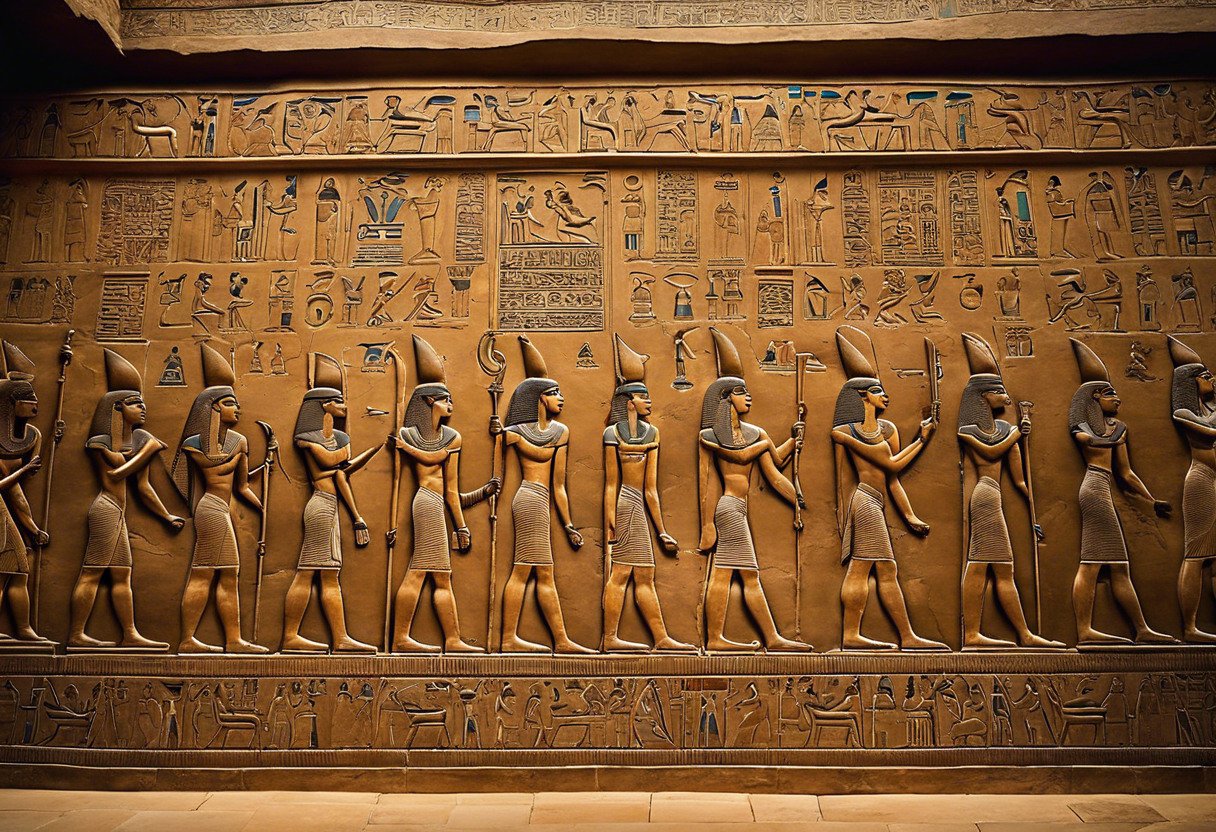
Ancient Egyptian society was deeply rooted in religious beliefs, with gods and goddesses playing a central role in every aspect of life. The Egyptians believed that these gods controlled the forces of nature, govern the afterlife, and could even intervene in human affairs. The importance of gods in ancient Egyptian society can be seen through various aspects of their culture, including their art, architecture, and daily rituals.
Gods as Protectors and Guardians
The Egyptians believed that their gods protected them from harm and guided them through life. They often depicted these gods in their artwork, showing them in powerful and majestic forms. For example, the god Horus was depicted as a falcon, representing his role as a protector. The pharaohs, who were seen as the earthly representations of the gods, would often wear crowns or headdresses that symbolized their divine connection and protection.
Gods in Daily Life
Every aspect of ancient Egyptian life was intertwined with their religious beliefs. From birth to death, the Egyptians sought the guidance and protection of their gods. They would offer prayers and sacrifices at temples and shrines, seeking blessings for a good harvest, protection in times of war, and fertility for their families. In return, it was believed that the gods would provide for their needs and ensure their well-being.
Gods in Art and Architecture
Art and architecture were important mediums for expressing the religious beliefs of the ancient Egyptians. Temples, tombs, and statues were built in honor of the gods, serving as places for worship and devotion. These structures were grand and elaborate, reflecting the power and status of the gods they were dedicated to. The artistic representations of the gods were carefully crafted and symbolically rich, conveying their divine attributes and significance to the people.
Gods and the Afterlife
Ancient Egyptians had a strong belief in the afterlife, and the gods played a crucial role in guiding the souls of the deceased to the afterlife. The god Osiris was believed to judge the souls and determine their fate. To ensure a successful journey, the deceased were buried with objects and amulets associated with the gods, such as the Book of the Dead. They also believed in the existence of deities such as Anubis, the god of mummification, who oversaw the embalming process and protected the body.
Gods as Symbols of Power and Authority
The belief in gods also served a political purpose. The pharaohs, as divine rulers, used their association with the gods to legitimize their power and authority over the people. By aligning themselves closely with the gods and building temples and monuments in their honor, the pharaohs reinforced their divine status and secured the loyalty and obedience of their subjects.
In conclusion, the gods held immense importance in ancient Egyptian society. They were seen as protectors, guides, and providers, with their influence extending into every aspect of daily life. The worship of gods was evident in the art, architecture, and rituals of the Egyptians, and their beliefs shaped their understanding of the afterlife. The gods also served as symbols of power for the pharaohs, helping to establish and maintain their authority over the people.
Exploring the Major Gods in the Egyptian Pantheon
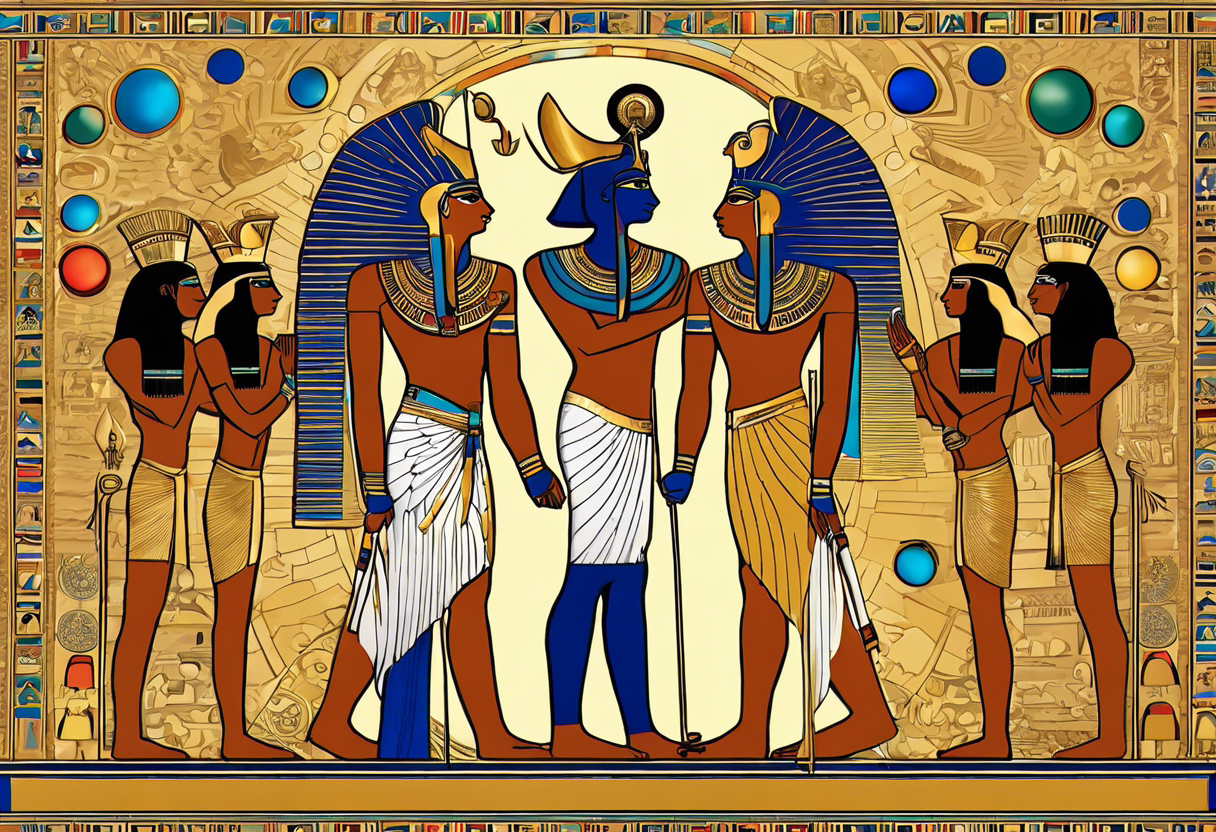
The ancient Egyptian pantheon is a rich and complex system of gods and goddesses, each with their own unique attributes and roles in the world. In this section, we will delve into some of the major gods in the Egyptian pantheon and explore their significance and characteristics.
Ra - The Sun God
Ra, also known as Re, was one of the most important gods in ancient Egypt. He was the god of the sun and the ruler of the gods. In Egyptian mythology, Ra was believed to have created the world and brought light and life to it. He was often depicted as a falcon-headed man or as a falcon, with the sun disk on his head. As the sun god, Ra was associated with power, light, and creation.
Osiris - The God of the Afterlife
Osiris was a prominent god in the Egyptian pantheon, revered as the ruler of the underworld and the god of the afterlife. He was often depicted as a mummified pharaoh, wearing a white cone-like headdress, and holding a crook and flail. Osiris played a significant role in Egyptian religious beliefs, as he was regarded as the judge of the dead and the one who granted eternal life to the righteous. He symbolized resurrection, rebirth, and the cycle of life and death.
Isis - The Goddess of Magic and Motherhood
Isis was one of the most revered goddesses in ancient Egypt, worshiped as the goddess of magic, motherhood, and fertility. She was the sister and wife of Osiris, and the mother of Horus. Isis was often depicted as a woman wearing a throne-shaped headdress or as a woman with wings. She was associated with nurturing, healing, and protection, and was invoked by Egyptians for assistance in matters of childbirth, love, and protection from evil spirits.
Horus - The Sky God and King of Egypt
Horus was a significant deity in Egyptian mythology, regarded as the sky god and the divine protector of the pharaohs. He was often depicted as a falcon or as a falcon-headed man, wearing the double crown of Upper and Lower Egypt. Horus symbolized kingship, sovereignty, and protection. He was believed to be the son of Osiris and Isis, and played a crucial role in the resurrection of his father and the defeat of his uncle Seth.
Thoth - The God of Wisdom and Writing
Thoth was the god of wisdom, writing, and knowledge in ancient Egyptian mythology. He was often depicted as a man with the head of an ibis or as a baboon. Thoth was associated with intellectual pursuits, magic, and the invention of writing. He was believed to have given language and writing to humanity, making him an essential deity for scribes and scholars. Thoth was also associated with the judgment of the dead and was considered as a mediator and arbitrator.
These are just a few examples of the major gods in the Egyptian pantheon, each with their own unique roles and characteristics. The ancient Egyptians revered these gods and goddesses, seeking their guidance, protection, and favor in various aspects of life. By exploring the central deities of ancient Egypt, we gain a deeper understanding of their culture, beliefs, and fascinating spiritual traditions.
The Role of Lesser-Known Gods in Ancient Egypt
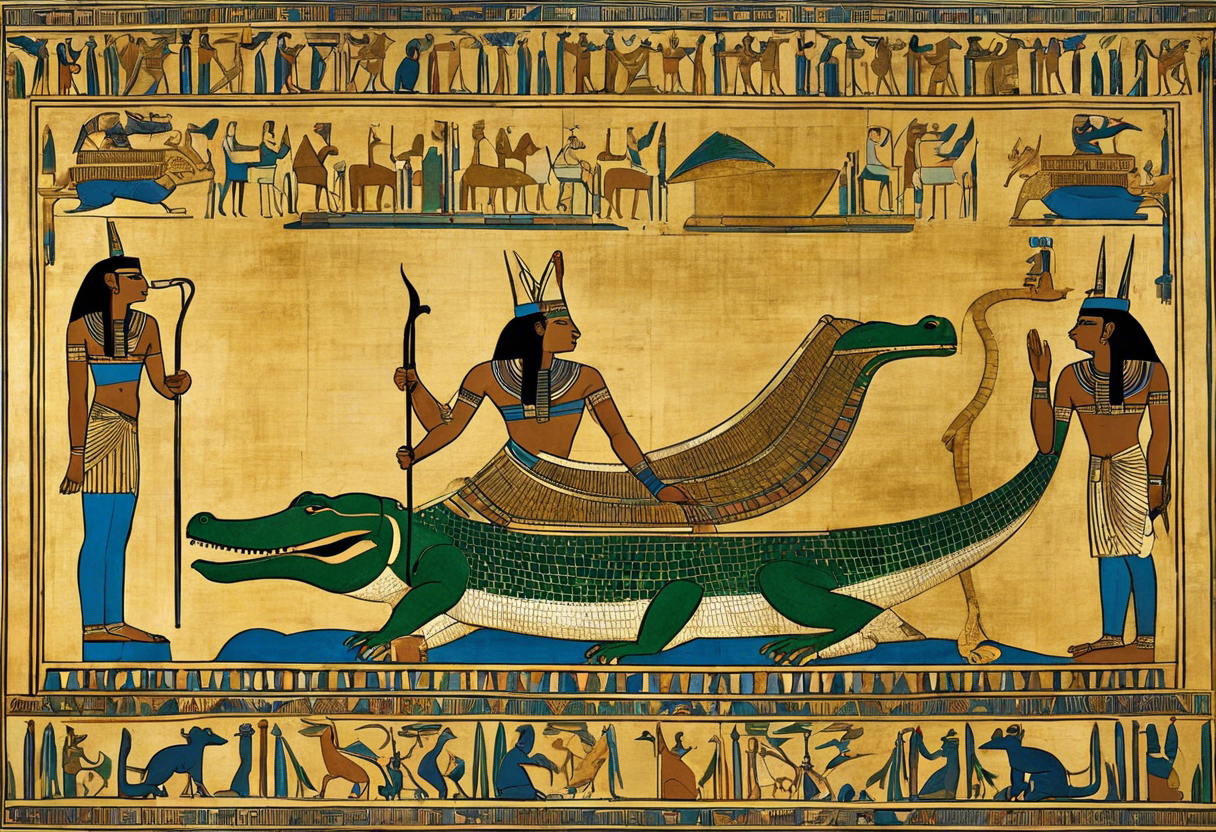
Ancient Egypt was home to a rich pantheon of gods and goddesses, many of whom were widely worshipped and celebrated. However, alongside these well-known deities, there were also numerous lesser-known gods who played significant roles in the ancient Egyptian religious belief system. While their names and stories may not be as familiar to us today, these gods held important positions and were revered by the ancient Egyptians for their unique attributes and functions.
One such lesser-known god is Khnum, often depicted as a ram-headed deity. Khnum was associated with creation and fertility, particularly in relation to the Nile River. He was believed to mold each individual's physical form on his potter's wheel and was therefore considered the creator of human bodies. Khnum was also associated with the annual flooding of the Nile, which was crucial for agricultural prosperity. His role as a lesser-known god highlights the significance of both creation and fertility in ancient Egyptian society.
Another lesser-known god is Taweret, a fearsome protective deity often shown as a combination of a hippopotamus, crocodile, and lioness. Taweret was revered as the guardian of pregnant women and newborns, believed to ward off evil spirits and protect against miscarriage or complications during childbirth. Her popularity among women and mothers exemplifies the importance of maternal and child health in ancient Egyptian society.
Among the lesser-known gods, Duamutef, one of the four sons of Horus, played a critical role in the afterlife. Duamutef was depicted as a jackal-headed deity and guarded the canopic jar that stored the stomach of the deceased. Each of the four sons of Horus was responsible for safeguarding a specific organ, and their role was crucial in preserving the integrity of the deceased's body for the journey into the afterlife. Duamutef's presence in the ancient Egyptian belief system highlights the intricate rituals and practices surrounding death and the afterlife.
Furthermore, Serket, the goddess of scorpions and healing, holds significance as a lesser-known deity in ancient Egyptian mythology. Known for her ability to protect against scorpion stings and other venomous creatures, she was venerated for her healing powers. Serket was often invoked during medical treatments and surgeries, highlighting the ancient Egyptians' belief in the power of divine intervention in matters of health and well-being.
Although these gods may not be as familiar to us today, their roles in ancient Egyptian religion were far from insignificant. They represented important aspects of life, such as creation, fertility, protection, and healing, that were essential to the ancient Egyptians' daily existence. The inclusion of these lesser-known gods in the ancient Egyptian pantheon reflects the intricacy and complexity of their belief system, showcasing the diverse and multifaceted nature of ancient Egyptian spirituality.
Understanding the Symbolism and Iconography of Egyptian Gods
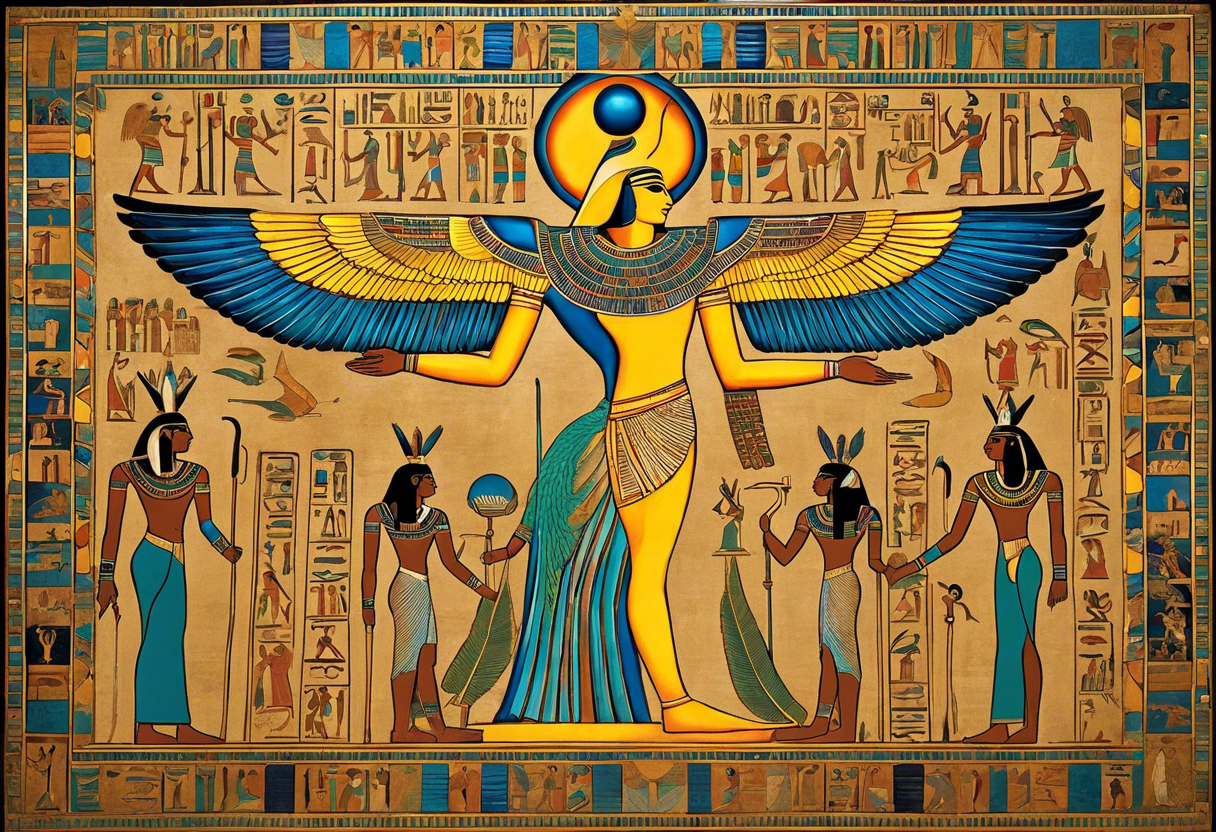
The Egyptian pantheon is rich with gods and goddesses, each with their own unique symbolism and iconography. Understanding the meaning behind these symbols and images can provide insights into the roles, attributes, and powers of Egyptian deities. By studying the symbolism and iconography of Egyptian gods, researchers and enthusiasts can delve deeper into the complexities of ancient Egyptian religion.
Symbolism of Egyptian Gods
The symbols associated with Egyptian gods serve as visual representations of their attributes, powers, and associations. Many of these symbols have deep-rooted meanings that connect various aspects of Egyptian cosmology, mythology, and society. Some commonly recognized symbols include:
The Ankh: This well-known symbol resembles a key or looped cross and represents life and fertility. It is often seen in the hands of gods, indicating their role as givers and sustainers of life.
The Djed: The Djed pillar is a symbol of stability and endurance. It is often associated with Osiris and represents his role as a god of the afterlife and resurrection.
The Eye of Horus: This symbol, often depicted as the eye of a falcon, symbolizes protection, health, and royal power. It is associated with the god Horus and is believed to have protective qualities.
The Scarab: The Scarab beetle is a symbol of rebirth and regeneration. It represents the sun god, Ra, and reflects the cycle of life and death in Egyptian mythology.
These symbols, among many others, hold significant meaning within Egyptian culture.
Iconography of Egyptian Gods
The iconography of Egyptian gods involves their representations in artwork and statues. Each god has distinctive iconographic features that further enhance their identification and understanding. Some common elements of Egyptian god iconography include:
Animal associations: Many Egyptian gods are depicted with animal heads or as animals themselves. For example, Horus is often shown with a falcon head, while Bastet is represented as a lioness. These animal associations connect the gods to specific powers and qualities associated with the animals.
Headdresses and crowns: The headdresses and crowns worn by gods often convey their authority and position. For instance, the pharaoh god Amun-Ra is depicted wearing a double plumed crown, signifying his ultimate authority.
Pose and posture: The pose and posture of Egyptian gods in artwork can also provide insight into their roles and significance. For instance, Osiris is often depicted in a mummiform pose, symbolizing his role as the god of the afterlife and resurrection.
Hieroglyphic inscriptions: Many representations of gods feature hieroglyphic inscriptions that provide additional information about their characteristics and attributes. These inscriptions often accompany the images and serve as textual support for understanding the gods.
By analyzing the iconography of Egyptian gods, scholars and enthusiasts can gain a deeper understanding of their roles, symbolism, and significance within ancient Egyptian religion.
Overall, the symbolism and iconography of Egyptian gods are integral to understanding their roles, attributes, and powers. Through careful study, researchers can uncover the hidden meanings behind the symbols associated with the gods and gain insight into their significance within ancient Egyptian society. Furthermore, the iconographic representations of the gods provide visual clues that enhance our understanding of their identity and purpose. Together, symbolism and iconography allow us to delve deeper into the complex world of Egyptian mythology and religion.
The Temples and Cults Dedicated to Egyptian Gods
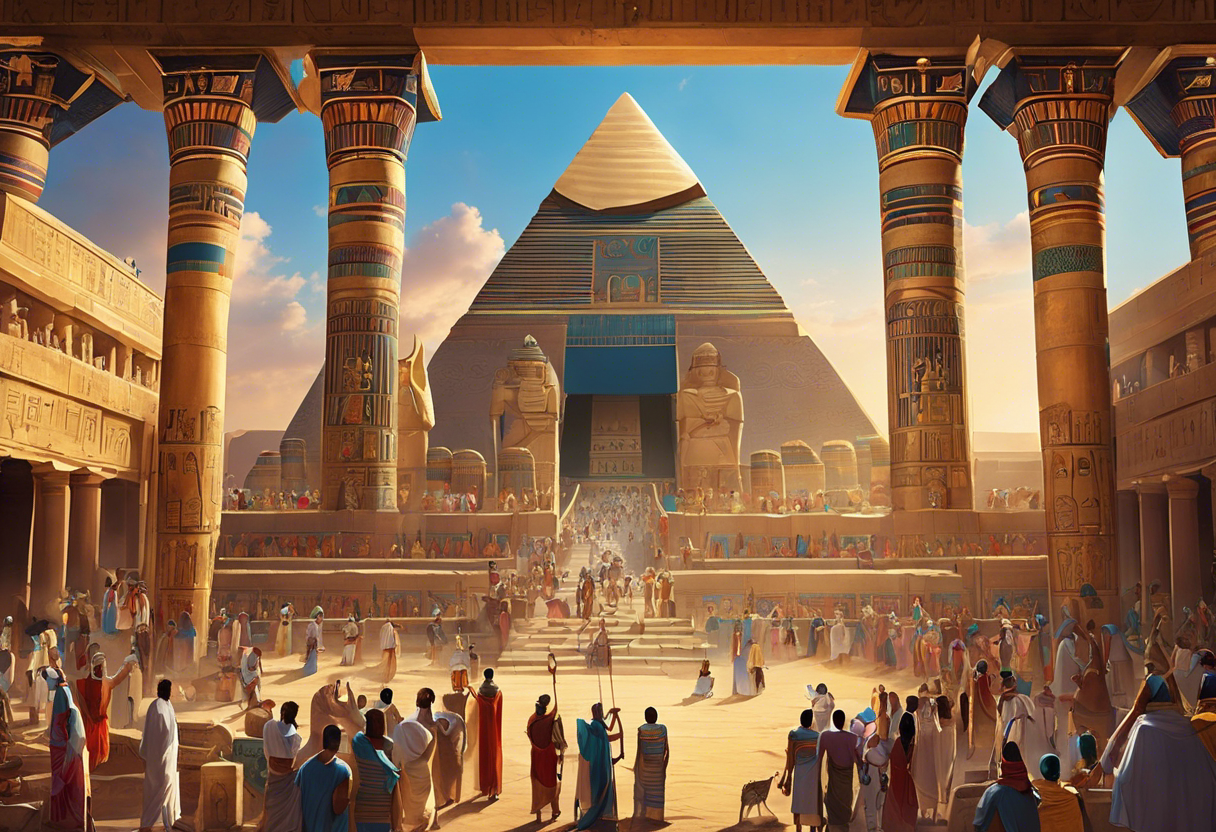
Ancient Egypt was renowned for its elaborate temples and cults dedicated to various Egyptian gods. These sacred sites served as centers of worship and played a vital role in Egyptian religious and cultural practices. The temples were believed to be the dwelling places of the gods, where they could communicate with and receive offerings from the mortal realm.
The construction of temples was an essential aspect of Egyptian society, reflecting both the religious and political power structures of the time. Pharaohs and rulers were responsible for the construction and maintenance of these grand structures, often dedicating them to specific gods associated with their royal lineages. The temples were built on a massive scale, featuring impressive architectural design, intricate carvings, and vibrant paintings that depicted scenes from ancient Egyptian mythology.
Each temple was dedicated to a particular deity or a group of related gods, and the cults associated with these gods served as the religious institutions responsible for their worship and rituals. The priests and priestesses affiliated with these cults held significant religious authority and played a crucial role in the performance of ceremonies and the maintenance of temple rituals.
Among the most prominent temples in ancient Egypt were the Temple of Amun at Karnak, the Temple of Horus at Edfu, the Temple of Isis at Philae, and the Temple of Hathor at Dendera. These temples attracted pilgrims from all over Egypt, who sought spiritual guidance, healing, and blessings from the gods. The temples also served as important economic centers, as they were often endowed with vast landholdings and acquired substantial wealth through offerings and donations.
The cults dedicated to Egyptian gods engaged in a variety of religious practices, including daily rituals, processions, and annual festivals. The priests and priestesses performed ceremonies to honor the gods and ensure their favor and protection for the entire society. These rituals involved offerings of food, drink, and incense, as well as the recitation of hymns and prayers.
The temples were not only places of worship but also served as administrative centers, where legal and economic matters were handled, and agricultural production and distribution were organized. They played a crucial role in maintaining the stability and prosperity of ancient Egyptian society.
The decline of ancient Egyptian civilization and the rise of other religions led to the abandonment and destruction of many temples. However, some of these sacred sites have survived to the present day and continue to be important cultural and historical landmarks, attracting tourists and scholars alike.
Studying the temples and cults dedicated to Egyptian gods provides valuable insights into the religious beliefs, social structures, and artistic achievements of ancient Egypt. Through these sacred sites, we can glimpse the rich and complex world of the ancient Egyptians and their enduring devotion to the gods they worshipped.
Rituals and Offerings to Honor Egyptian Gods
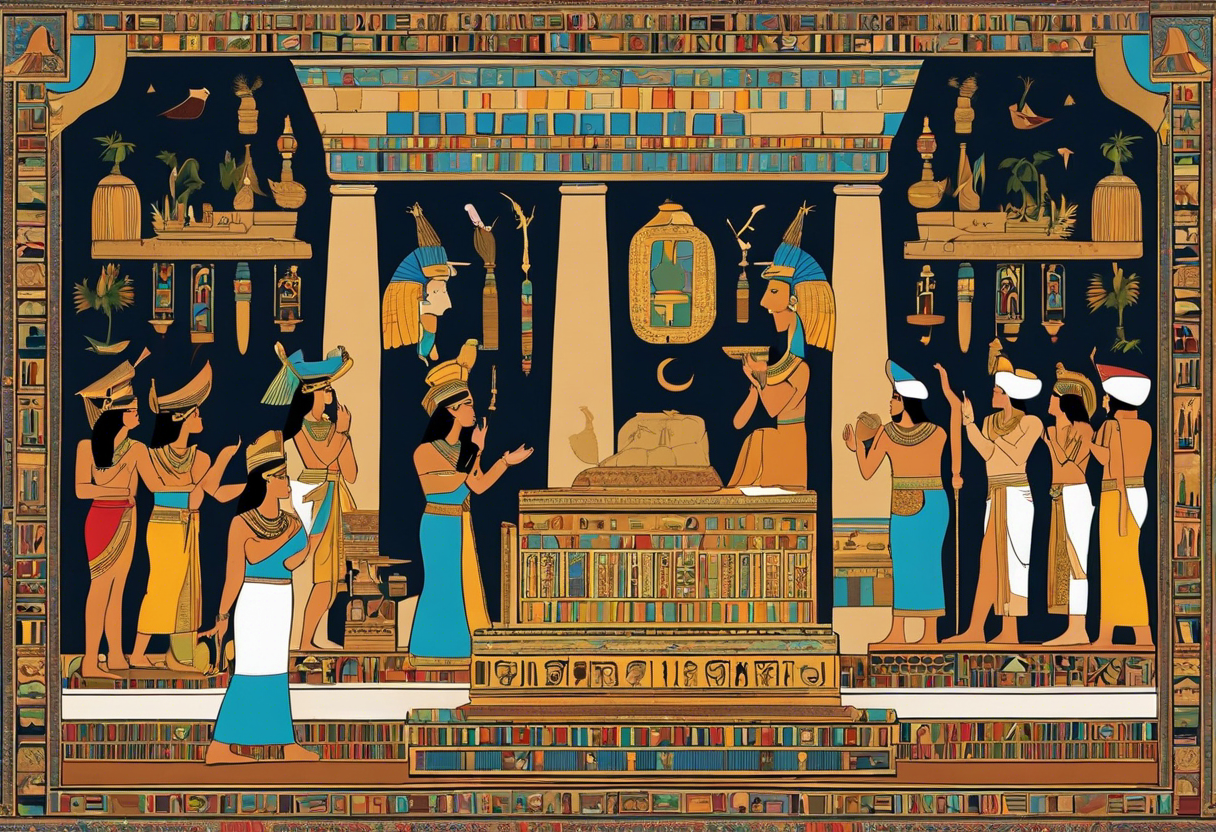
The ancient Egyptians believed in the importance of honoring their gods through rituals and offerings. These rituals played a crucial role in maintaining a harmonious relationship between the gods and the people. Here are some of the rituals and offerings that were commonly performed to honor the Egyptian gods.
Daily Offerings: Egyptians believed that providing daily offerings to their gods was essential in maintaining their favor and protection. These offerings often consisted of food and beverages, such as bread, beer, fruits, vegetables, and meat. They were presented on altars or in special offering tables in temples and shrines.
Incense and Fragrances: Incense and fragrances were believed to please the gods and create a pleasant atmosphere during the rituals. These aromatic substances, such as myrrh, frankincense, and kyphi, were burned as offerings, releasing fragrant smoke that was thought to carry prayers and wishes to the gods.
Litanies and Hymns: Litanies and hymns were recited or sung during the rituals to praise and honor the gods. These sacred texts acknowledged the gods' power and divine attributes, invoking their blessings and protection upon the worshippers. Priests and devotees would often perform these litanies and hymns during religious ceremonies.
Processions: Processions were grand events held on special occasions, such as festival days or the re-enactment of mythical events. Statues of the gods were carried in sacred boats or on portable shrines and paraded through the streets. These processions were accompanied by music, dancing, and chanting to honor and glorify the gods.
Sacrifices: Animal sacrifices played a significant role in Egyptian rituals. Certain animals, such as bulls, cows, goats, and birds, were considered sacred to specific gods. These animals were ritually slaughtered, and their offerings were presented to the gods as a symbol of devotion and gratitude.
Offering Tables: Offering tables were important fixtures in Egyptian temples and households. These tables were adorned with offerings such as food, beverages, and personal belongings of the worshippers, symbolizing their willingness to share their provisions and possessions with the gods.
Anointing and Ankh: Anointing with oils and the ankh symbol were common practices during rituals. Priests and devotees would anoint statues with perfumed oils, believed to confer life and vitality upon the gods. The ankh symbol, representing life, was also offered as a symbol of devotion and as a wish for eternal life.
In conclusion, rituals and offerings were integral to the worship of the Egyptian gods. By performing these rituals and presenting offerings, the ancient Egyptians sought to maintain a harmonious connection with their gods and ensure their favor and protection. These practices reflected a deep and fervent belief in the power and presence of the gods in daily life.
The Influence of Egyptian Gods on Art and Architecture
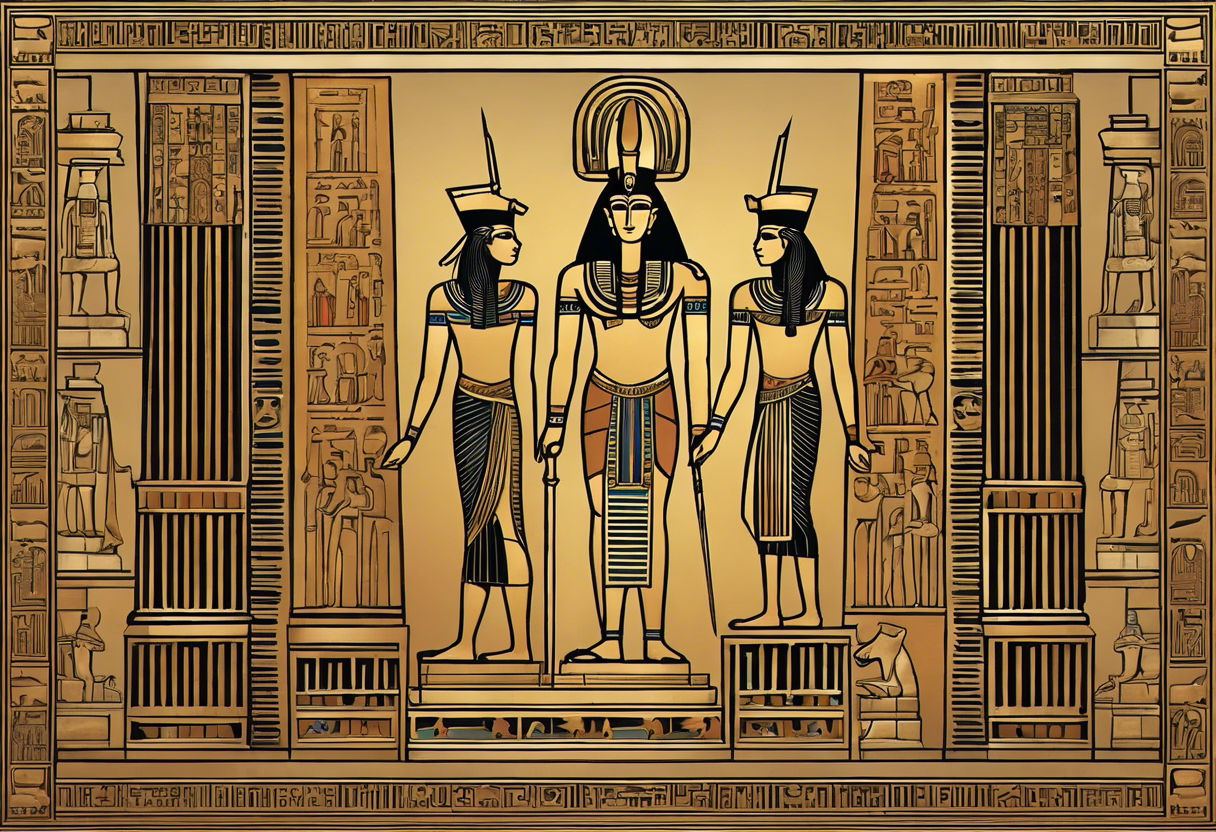
The ancient Egyptian gods had a profound influence on the art and architecture of Egypt. Their mythology and religious beliefs were deeply ingrained in every aspect of the Egyptian civilization, including their artistic expressions and architectural designs.
- Depiction of Egyptian Gods in Art
The gods were often depicted in Egyptian art in human form but with animal features or symbols that represented their attributes or associations. For example, the god Ra, who was the sun god, was often depicted with a falcon head and a sun disk on top. Similarly, the goddess Hathor, associated with fertility and motherhood, was often represented with cow ears or a cow head. These depictions were not only a way to visually represent the gods but also served as a means to convey their powers and characteristics to the people.
- Religious Themes in Egyptian Art
Religious themes were a dominant part of Egyptian art. Scenes from mythological stories involving the gods were commonly depicted on tomb walls, temple murals, and papyrus scrolls. These artistic representations served a religious purpose and were believed to not only honor the gods but also guide and protect the deceased in the afterlife. The gods were often portrayed as powerful and larger than life figures to emphasize their divine status and highlight their importance in Egyptian religious beliefs.
- Gods as Patron of Architecture
The influence of Egyptian gods extended to architectural designs as well. Each god had their own temples, which were considered their dwelling places on Earth. These temples were designed and built to reflect the attributes and symbolism associated with the respective deity. For example, temples dedicated to the god Amun-Ra, the king of gods, were grand and majestic, reflecting his supreme power. These architectural masterpieces were not only places of worship but also served as a visual representation of the god's dominion and grandeur.
- Symbolism in Egyptian Architecture
Many architectural elements and motifs were also imbued with symbolic meanings associated with the gods. For instance, the obelisks, towering structures with a pyramid-shaped top, were considered sacred to the sun god Ra. The pyramid shape itself symbolized the sun's rays and the god's eternal power. The use of hieroglyphics, the Egyptian writing system consisting of pictorial characters, also had a strong religious connection. Hieroglyphics were often used to inscribe religious texts and prayers on temple walls, connecting the divine word with physical structures.
In conclusion, the influence of Egyptian gods on art and architecture cannot be overstated. The gods were not only depicted in various artistic forms but were also deeply intertwined with the religious themes and symbolism of Egyptian art. Their presence was felt in the grand temples and architectural designs dedicated to them, making them an integral part of ancient Egyptian culture and belief system.
The Legacy of Egyptian Gods in Modern Culture
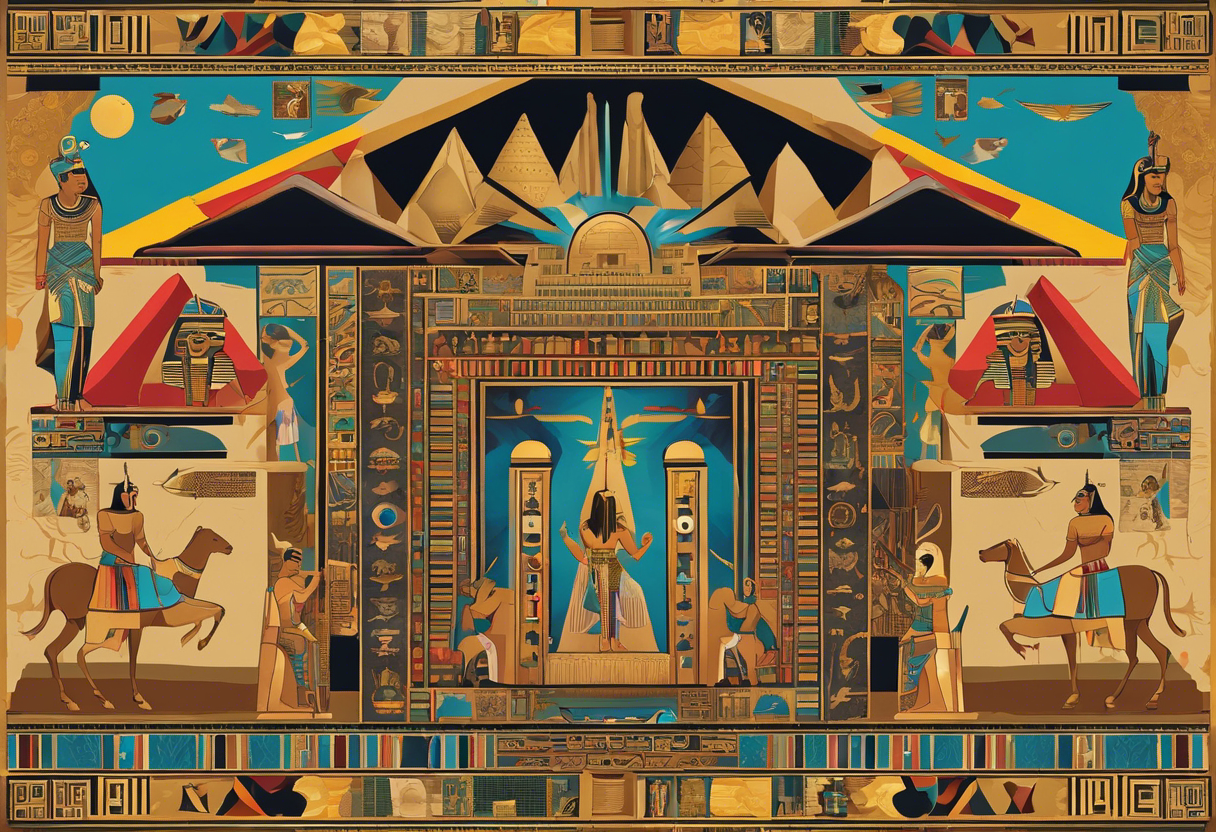
The rich mythology and pantheon of Egyptian gods has had a profound and lasting impact on modern culture. From art and architecture to literature and film, the legacy of these ancient deities can be seen in various aspects of contemporary society.
Art and Architecture
One of the most prominent ways in which the influence of Egyptian gods can be seen is in art and architecture. The iconic figures of gods such as Ra, Isis, and Anubis have been depicted in countless paintings, sculptures, and murals. Their distinctive characteristics, such as animal-headed forms and regal postures, have become instantly recognizable symbols of ancient Egypt.
In architecture, the grandeur and majesty of Egyptian temples and tombs have inspired numerous buildings around the world. The use of hieroglyphs, gods, and sacred symbols in the design of structures such as government buildings, museums, and even hotels pays homage to this rich cultural heritage.
Literature and Film
Ancient Egyptian myths and legends have also played a significant role in literature and film. Countless authors and filmmakers have drawn inspiration from these tales, incorporating them into their works. From novels like Agatha Christie's "Death on the Nile" to movies like "The Mummy" franchise, the allure of Egypt and its gods continues to captivate audiences.
Whether it is the story of Osiris and Isis or the adventures of the famous pharaoh Tutankhamun, these narratives offer thrilling plots and an element of fantasy that continues to enthrall readers and viewers alike.
Popular Culture and Fashion
The fascination with Egyptian gods can be seen in popular culture and fashion as well. From iconic symbols like the Eye of Horus appearing on clothing, accessories, and tattoos, to Egyptian-inspired fashion designs on runways, the influence of these deities pervades modern style.
Celebrities and musicians have also embraced this ancient aesthetic, incorporating elements of Egyptian mythology and iconography into their performances, music videos, and stage costumes. This fusion of ancient and contemporary culture adds a touch of mystique and grandeur to the entertainment industry.
Education and Museums
Lastly, the legacy of Egyptian gods can be observed in the realm of education and museums. Egyptian mythology is a staple in school curricula, providing students with an understanding of ancient belief systems and cultural practices. Museums around the world house impressive collections of Egyptian artifacts and artworks, allowing visitors to delve into the world of these gods and gain a deeper appreciation for ancient Egyptian civilization.
These institutions play a vital role in preserving and disseminating the knowledge of Egyptian gods, ensuring that their legacy continues to be appreciated by future generations.
In conclusion, the Egyptian gods have left an indelible mark on modern culture. Their influence can be seen in various aspects of contemporary society, from art and architecture to literature, film, popular culture, and education. The fascination with these deities continues to captivate the imagination and enrich our understanding of ancient Egypt.
Conclusion

The Ancient Egyptian God List provides a fascinating glimpse into the rich and complex religious beliefs of the ancient Egyptians. This comprehensive guide has explored the various deities listed in the document, shedding light on their roles, attributes, and relationships with one another.
Through the examination of the different categories and groupings within the god list, it becomes clear that the Egyptians had a highly organized and intricate pantheon, with gods and goddesses representing various aspects of the natural world, human life, and the afterlife. From powerful creator gods to deities associated with fertility, wisdom, or protection, each god had a specific purpose and domain that played a crucial role in the lives of the ancient Egyptians.
One of the remarkable aspects of the Ancient Egyptian God List is its inclusive nature. It includes not only well-known gods like Osiris, Isis, and Ra, but also more obscure deities that were localized or had specialized roles within specific regions or cults. This emphasizes the diverse and decentralized nature of ancient Egyptian religion, where worship varied from one city or community to another.
Moreover, the interconnectedness and syncretism evident in the god list further highlight the complex nature of Egyptian religious beliefs. Many deities were associated with multiple domains or merged with other gods over time, creating a dynamic and ever-evolving pantheon. These fluid associations demonstrate the adaptability and flexible nature of ancient Egyptian religion, allowing for the incorporation of new gods and ideas into the existing belief system.
The Ancient Egyptian God List serves as an important primary source for understanding the religious beliefs and practices of this ancient civilization. It provides valuable insights into how the Egyptians perceived and interacted with their gods, as well as the significance of these deities in their daily lives. By studying this document, researchers and scholars can gain a deeper understanding of the complexities and nuances of ancient Egyptian religion, offering valuable insights into the cultural, social, and spiritual aspects of this fascinating civilization.
In conclusion, the Ancient Egyptian God List is a testament to the profound religious significance and diversity of ancient Egyptian society. It showcases the multitude of gods and goddesses worshipped by the Egyptians and reveals the intricate relationships and roles they played within their cosmology. By studying this comprehensive guide, we can gain a deeper appreciation for the religious beliefs and practices of one of the most influential civilizations in history.
